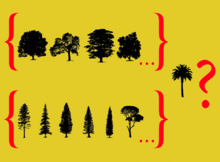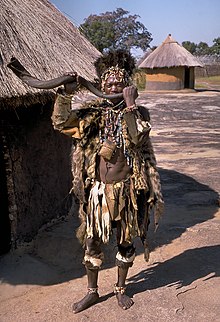Categorization (cognitive science)

Categorization or categorical thinking is called the cognitive ability to intuitively sort different entities (objects, living beings, processes, abstracts) and to subordinate them to corresponding collective terms (categories). These categories are based on certain similarities or on comparison with previous theoretical knowledge . The formation of categories is a fundamental process in the interpretation and evaluation of perceptual content , the understanding of concepts and objects , in decision-making processes and in all types of interaction with the environment. Accordingly, categories are the basic concepts of our thinking.
The terms "categorization" and " classification " are often used synonymously. In the narrower sense, however, “classification” rather stands for the deliberately planned order of knowledge in the context of a concrete consideration according to objectifiable, uniform criteria (often in mathematics , natural science and technology ).
In contrast, “categorization” rather describes the unconscious , intuitive or traditional process of class formation for any objects or events of everyday perception. This universal ability is seen in philosophy , psychology , ethnology and other anthropological sciences as an essential foundation of human cultural development .
In contrast to scientific classes , everyday categories are full of exceptions: not all the characteristics that determine a category have to apply, but only a sufficiently large number (example: ostriches and rheas cannot fly, but children also spontaneously assign them to birds).
A clear example of the targeted use of the categorization ability is the organizational method of mind mapping .
Category and chaos
The ability to categorize - for which various explanatory models exist - always presupposes abstraction (concept formation). Every person involuntarily classifies any objects of perception into known categories. He can therefore react adequately to a situation, deal productively with his environment and communicate more efficiently: Such categories enable us, among other things, to quickly identify potential dangers (e.g. the categories: "snakes", "predators", "weapons") ) and to tell other people something about our own perception.
Behavioral biologists now assume that animals such as great apes , horses or even pigeons can already form mental categories.
Everyday categories bring order to the chaos and reduce the infinity of the world to a tangible level. It is irrelevant whether this imaginary order actually corresponds to reality (such as the centuries-long assignment of bats to birds); the decisive factor is their suitability for survival. The entirety of our categories forms a greatly simplified, well-ordered model of reality: This applies to the highly complex theories of modern science, to the “rules of thumb of everyday life” and also to the mythical-magical thinking of traditional, indigenous cultures.
Mental categories often exist in the form of complementary pairs of terms ( dichotomies ), which, depending on the cultural background, are perceived as irreconcilable opposites or as mutually dependent "opponents" or changing states. The ethnologist Claude Lévi described them through the omnipresence of such dichotomies ( true ↔ false , alive ↔ dead , old ↔ young, black ↔ white, north ↔ south, human ↔ animal , this world ↔ hereafter , nature ↔ culture etc.) in the most varied of cultures - Strauss as a basic pattern for any categorization. The fact that a large number of opposites do not stand up to a logical test and are merely "counter words" ( antonyms ) without a real background (such as dog / cat or shirt / pants) does not matter, but rather reinforces the idea of an "innate dualism in humans ´ “. In many philosophical schools of antiquity (e.g. Heraklit and Parmenides ), modern times ( Descartes , Schelling , Jaspers , Heidegger , Sartre , Popper, etc.) and especially in the Far Eastern worldviews (e.g. Yin and Yang in Daoism , Hinduism or Buddhism ) dichotomous leading categories play a prominent role.
Types of categories
In psychology , different systems of intuitive categories are differentiated according to the way they are assigned. An important distinction is made between categories for living beings and for dead objects. The assignment to living beings is mainly based on invisible features (the assumed inner being ), less on the external appearance. This is particularly important when assigning people to certain categories such as B. "Christians" or "students" clearly. Inanimate objects - in particular cultural artefacts - are, on the other hand, sorted exclusively according to their external and functional characteristics.
Objects that apparently cannot be classified into a category were seen in many cultures as manifestations of evil, of unpredictable chaos. This “category of the non-category” includes animals such as snakes, dragons or crocodiles in their mythological symbolism .
Categories that summarize large parts of the world in one term are called guiding or metacategories . Even more than simple terms, they are indicators of the typical thought structures in a culture. Leading categories in industrial societies are, for example, the dichotomies “order ↔ chaos”, “culture ↔ nature”; as well as the terms " progress ", " reason ", " contingency (everything is possible)" or " waste " (in the sense of useless objects or people)
Category change
Since categories only represent a model of reality, it is inevitable that classifications will change due to new findings (example: bats and beavers are no longer classified as birds or fish, but rather as mammals).
Changes in the key categories also reflect the more or less rapid cultural change in each society (see also sociocultural evolution ). Since the transition from modernity to postmodernism , the “progress” category has been viewed increasingly critically. Another example - which has caused a lot of discussion - is the change in the collective term " primitive peoples ": This 19th century scientific class was seen as the opposite of the so-called "civilized peoples" and was based on the (false) notion that Europeans would become Control nature in contrast to other peoples. With the changed meaning of the concept of culture in the 20th century, the class "primitive peoples" was abandoned in science. In general usage, however, the term continues to exist as a conventional category, which is no longer associated with a (negatively connoted) alleged lack of culture, but with the (positively connoted) nature-loving way of life of the so-called groups of people.
Explanatory approaches
The classic view
The classic Aristotelian view is that categories are discrete entities characterized by a set of properties common to all of their elements. It is believed that these constitute the conditions that are both necessary and sufficient for detection.
Cognitive science perspective
In the 1970s, research by Eleanor Rosch and George Lakoff spread the idea that categorization could be viewed as a process based on prototypes. The prototype semantics assumes that the ideal categorizations never take place exactly, but can only gradually approximate an abstract prototype.
Hierarchical order
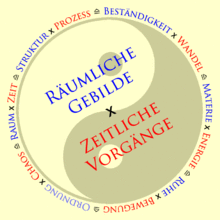
The categorization of the world leads to a large number of hierarchically sorted levels of abstraction: for each term there are more specific sub-terms, for a certain set of terms there are more general generic terms. Extension and intension (scope and content) are in a reciprocal relationship: the more general term has a larger scope and less content. The more specific term has a smaller scope with a higher content. But even these classifications have problem cases in which one cannot say exactly where an element is sorted (e.g. red throats, blackbirds, starlings, (bat?) = Birds / birds, fish, insects = animals / animals, plants , Mushrooms = living beings etc.). In scientific classification, the entirety of such hierarchies is called taxonomies .
On the top ( ontological ) level of abstraction, the categories flow into a complementary pair of terms : The world appears separated into spatial structures and temporal processes , which are expressed in different variants depending on the perspective (such as persistence ↔ change / reproduction ↔ new creation / rest ↔ movement) . All categories can be traced back to this. The logic of the categorization involuntarily follows the laws of material and social survival and the "first perceived opposition of human perception": I ↔ world. Again, it becomes clear that it is inevitable to split the world into such categories when in reality it is an integrated whole .
The power of categories

Everyday categories are culturally determined: While they efficiently simplify communication within a culture, they can make understanding with members of other cultures more difficult. If, for example, a German and an Egyptian talk about trees, this word is likely to evoke the visual image of a deciduous or coniferous tree in the former, while the latter is more likely to evoke the image of a palm. If the category “trees” is not explained, misunderstandings can easily arise. The more general and abstract a category, the greater the danger.
Categories are comparable to extremely highly compressed digital photos : They require little storage space and can be accessed very quickly. However, the disadvantages are just as similar: even the photographic recording reduces the quasi-infinite three-dimensional world to a tiny, two-dimensional section. The compression then reduces (and falsifies) the information again to a considerable extent.
Since the perception of reality inevitably takes place in an extremely compressed category model by virtue of our biological presuppositions, it requires philosophical reflection in order to recognize that this is not reality itself. Immanuel Kant already postulated this important limitation of our cognitive ability , which breaks down the incomprehensible cosmos into conceptually comprehensible individual parts with artificial limits and spiritual ingredients . However, the conscious search for the reality behind the categories is the exception, since we inevitably have to permanently orientate ourselves to the inner model in order to cope with the world. We very often use the categories and terms we have learned without knowing exactly what they represent.
This becomes particularly clear with the first contact with strangers: It is almost impossible not to categorize the person personally , in other words, to put the person "in an existing drawer" ( stereotype ) based on the first impression . If this “drawer” is already filled with prejudice , it becomes difficult to get to know the person for who they really are. The astonishing effects of expectations based on personal categories are well known: for example, students who are mistakenly presented to a new teacher as failures can actually fail if the prejudice persists. This even applies to the expectations of the investigator of scientific experiments: Our "inner world model" is therefore extremely powerful, it has a considerable influence on our judgment and can even have a changing effect on reality. (see also: Self-fulfilling prophecy )
On closer inspection it is a trivial realization that sharp boundaries between phenomena are the exception in reality. In fact, there are almost exclusively flowing transitions. Categories, on the other hand, suggest clear dividing lines: The problem of demarcating vegetation zones or cultural areas as well as the phenomenon of racism illustrate this impressively. Boundary categories are omnipresent in our terms, ideas and values so that they are the essential basis of any worldview that consciously or unconsciously guide our actions.
Even in modern, enlightened times, ideologically falsified conceptual constructs have a decisive influence on our lives. So it is not surprising that today all human activity is legitimized with mathematical categories such as the “monetary value” of a thing or its “economic importance”: even when it comes to living beings or existential conditions such as pure air or non-poisoned water.
“Nature and culture”: leading category (s) with conflict potential
Every human society has its own ontological category system to conceptually grasp the diversity of the world. Understanding other key categories requires an exceptionally high level of intercultural competence and a deep understanding of the respective worldview. In this context, the different understandings of the terms nature and culture show what great potential for conflict is associated with them. This is particularly clear when comparing the European view with that of non-industrialized, traditional peoples; however, it is already evident within European philosophy.
European worldviews: humans as causers
“Nature is by no means the great primal mother who gave birth to us. She is our creation. It is our imagination that inspires them. "



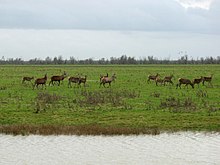

New categories and terms are created whenever communication about certain objects of perception or conceptual constructs becomes more and more complicated. Can new content make sense - i. H. in the context of the worldview of those involved - integrate it into the existing conceptual order system and summarize it under a collective name, it is a new category. The European concept of culture goes back to the innovation of agriculture in the Neolithic ( cultivating the soil ).
The more abstract (that is, the more generalized and the less concrete) a category is, the more unrealistic it depicts the world and the more it primarily serves the “we-feeling” of those involved. The price of this process is the "humanization" of the world: In order to understand it better, artificial boundaries are drawn; and an always latent danger is the confusion of this world model with reality. The key categories “nature” and “culture”, which are important for European thought, are a striking example of the far-reaching consequences of the inherent ideological component.
The general view
In everyday western thinking, the two expressions are used with such different meanings that it is not possible to formulate an exact definition. The only consistent aspect is generally seen as the relation to humans as the causer: that which was not created by humans is called nature ; in contrast to artificially created culture .
At first glance, this basic definition seems suitable for sharply delimiting nature and culture; analogous to a mutually exclusive either / or opposition such as “cause or effect” or “life or death”. On closer inspection, however, this assignment of meaning becomes more and more problematic, the more abstract the use of the term is: In relation to individual objects of perception, the assignment is simple - although there are already doubts here (bear, mushroom, stone = nature / house, knife, language = culture / Dog, wood, human =?) On a larger scale, however - in the sense of “ natural ” and “ cultural landscapes ” (forests, mountains, rivers ↔ cities, fields, canals) - the definition can be criticized in many ways. At this level, there are two complementary and polar terms rather than a categorical opposition: nature and culture are not mutually exclusive, but merely mark the imaginary ends of a scale with states of mixed fluid transitioning into one another ( hemerobia ).
Philosophical conceptual controversies
The problem of delimitation, which is already evident in the general categorization, has led to controversial positions in European philosophy. It also becomes clear that these disputes are inevitably about the ideological legitimation of certain ideas: The focus is not on what nature and culture "are", but what they "should be". This is illustrated above all by the two extreme positions of naturalism (often represented by conservationists) and culturalism (often by representatives of the economy). The naturalist negates culture through the universally effective laws of nature and through the fact that man himself is primarily a naturally created being. He sees (almost) everywhere the unalterable workings of nature; be it in diseases and natural disasters or in the dandelion breaking through a layer of asphalt. The culturalist, on the other hand, negates nature in the sense that it is primarily a conceptual construct of the human mind and that the world is (almost) everywhere and at all times subject to human access. Especially in times of anthropogenic climate change, human activity can be demonstrated even in the most remote regions; most of the so-called “ wilderness ” have been influenced by humans in some way for millennia and every nature reserve is defined by humans within its limits.
The controversy over the definition of nature and culture takes place particularly in areas that affect aspects of natural science and culture (e.g. cognitive science , behavioral research , systems science , ecology , ethnology ) . Since it is not about reality itself, but about category concepts, all positions are contestable. This is particularly evident when looking at man himself: Man, thought of as a natural being, also produces the “unnatural”; as a cultural being, on the other hand, its physical abilities are largely determined by the “non-cultural”. It is not possible to resolve the other term; the inseparable dichotomy remains. If, instead, one assumes flowing transitions between the poles of nature and culture, no limit can be described, which in turn makes the terms worthless.
An additional (ideological) problem is the latent, evaluative secondary meaning of the terms; the intuitive connection to the opposition of “good and bad”. For the culturalist, nature is often synonymous with the wild, the unhistorical, the misunderstood, the chaotic ; while the naturalist will locate this “evil” in the alienated, unnatural, degenerate, imperfect culture.
The roots of the leading European categories
“Good and bad” are typically European key categories that are closely related to elementary Christian values . The equation of evil with untamed nature can already be demonstrated in early Christian writings.
European ideology ( Eurocentrism ) has been fundamentally shaped by both Christian values and ancient metaphysics . The latter founded the principle of reason and, as a result, the desire for a scientifically proven, realistic explanation of the world. Above all, this requires a clear demarcation of the cognitive human being from nature: This is achieved, among other things, by "capturing" unlimited, flowing processes in limiting terms that are based on the material world ( physicalism ) and through a predominant consideration "from below" on the building blocks of the world defined in this way ( reductionism ), instead of “from above” on the complex systemic events ( holism ).
Chthonic worldviews: Man as controller
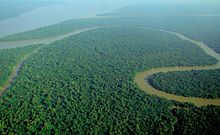
"The man who sat in his tipi on the ground and thought about life and its meaning, believed in the relationship of all creatures and recognized the unity of all life in infinity, opened the eyes to the meaning of every real culture."
Most of the earthly (chthonic) communities , which live in close interweaving with their environment according to ancient ways, do not have a concept of nature in the European sense. In the holistic conception of ethnic religions, people see themselves as an integral, inseparable part of their living space, including all products and ideas they have created themselves. This notion has led some ethnologists to the conclusion that there would be no idea of culture here, hence no demarcation between humans and no dualism between nature and culture.
However, other anthropologists have shown that even a small change in the concept of nature or culture refutes the apparent lack of this complementary leading category in traditional cultures: becomes culture - similar to European culturalism - as "everything that is within the human-possible effectiveness" and nature Defined as the “outside other”, the entire human environment becomes a cultural area. In fact, they consider all areas of their territory to be influenced. Even the areas that Europeans only consider to be influenceable through the possibilities of technology (mountains, rivers, climate, health), have always been under their control for chthonic people through the conviction of a mythical-magical connection between human beings, the environment and the spirit world ( see totemism , animism ). Nature, on the other hand, is in this sense the area of the world that lies outside of the known habitat : the wilderness of the unknown , the home of other peoples with strange, incomprehensible, frightening characteristics and the world of the gods. If the terms nature / culture are transformed in this way, the relationship to early Christian thinking becomes recognizable, because for the chthonic human being, too, nature (in the aforementioned terms) is evil, indomitable, non-human and culture is good, known and Human. In relation to the academic controversy over the designation " primitive peoples ", the above-mentioned worldview shows that these people also belong to the "civilized peoples", so that such a distinction becomes obsolete.
Conclusion
The existence of a complementary ontological leading category is completely independent of whether an abstract pair of concepts such as nature / culture is present or not. The difference to the western conception is gradual and not fundamental. The European ideas must not simply be transferred to the ideas of other cultures. Leading categories are never free from ideological traits and do not represent the real conditions, but the ideas of their creators. It should be noted that there are no right or wrong ideas in this sense.
See also
literature
- Michael R. Waldmann: Concepts and Categories. In: Joachim Funke, Peter A. Frensch (Hrsg.): Handbuch der Allgemeine Psychologie - Kognition. Hogrefe Verlag, Göttingen et al. 2006, ISBN 3-8409-1846-4 , pp. 283-293.
Individual evidence
- ↑ MI Jordan, S. Russel: Categorization. In: The MIT Encyclopedia of the Cognitive Sciences. The MIT Press, Cambridge, Massachusetts 1999, pp. 104-106.
- ↑ a b Francis Austeda: Categories. In: Lexicon of Philosophy. 6th, expanded edition. Brothers Hollinek publishing house, Vienna 1989, p. 184.
- ^ Hans Uszkoreit, Brigitte Jörg: Information science and information systems. Lecture notes, specialization in general linguistics, Saarland University.
- ↑ See Roland Posner : Culture as a system of signs. For the semiotic explication of basic concepts in cultural studies. In: Aleida Assmann, Dietrich Harth (Hrsg.): Culture as lifeworld and monument. Fischer, Frankfurt am Main 1991, pp. 37-74.
- ↑ a b c d e f g h i Stephan Bühnen: Culture and Cultures. In: Ulrich Veit, Tobias L. Kienlin, Christoph Kümmel (Ed.): Traces and messages. Waxmann Verlag, Münster 2003, ISBN 3-8309-1229-3 , pp. 494-497.
- ↑ Johannes Dölling: Semantics and Pragmatics. Lecture notes. Institute of Linguistics, University of Leipzig.
- ^ R. Leakey, R. Lewin: The origin of humans. Fischer, Frankfurt am Main 1998, pp. 303-304.
- ↑ EB Hanggi, JF Ingersoll: Long-term memory for categories and concepts in horses (Equus caballus). In: Animal Cognition. 12 (3) 2009, pp. 451-462.
- ↑ Perspectives: Pigeons as Art Connoisseurs: Monet or Picasso? In: FOCUS magazine. No. 18, April 29, 1995.
- ↑ Ministry for Rural Development, Environment and Consumer Protection of the State of Brandenburg: Night owls - bat protection in Brandenburg . Potsdam 2008.
- ↑ Expert decisions: Skilfully simple! Max Planck Institute for Human Development, Berlin, July 31, 2013, accessed on September 10, 2014.
- ^ A b Claude Lévi-Strauss: La pensée sauvage. 1962. (German edition: The wild thinking. Translation by Hans Naumann. Suhrkamp, Frankfurt am Main 1968).
- ↑ a b Hanna Rheinz : The manipulated soul. Thieme, Stuttgart 1995, pp. 90, 107.
- ↑ Richard Dawkins : The God Delusion. 10th edition. Ullstein, Berlin 2011, p. 250.
- ↑ Wilhelm Weischedel : The philosophical back stairs. dtv, Munich 1994, p. 26.
- ^ Alan Watts : The course of the water. 1st edition. Suhrkamp, Munich 1983, pp. 43-44, 51-52, 63.
- ↑ Max Fuchs : Pedagogy and Modernity: Studies on the cultural foundations of educational science. Herbert Utz Verlag, Munich 2013, p. 210.
- ↑ a b c Matthias Junge, Thomas Kron (ed.): Zygmunt Bauman : Sociology between postmodernism, ethics and diagnosis of the present. 3. Edition. Springer, Wiesbaden 2014, p. 5.
- ↑ a b c d e Klaus E. Müller : The better and the worse half. Ethnology of the gender conflict. Campus, Frankfurt am Main / New York 1984, ISBN 3-593-33360-0 , pp. 389-399, in particular 389-391.
- ↑ Nicolai Hartmann : Philosophy of Nature: Outline of the special category theory. 2nd Edition. Walter de Gruyter, Berlin 1980, pp. 45, 59, 79, 537-540.
- ↑ Ervin László : Cosmic Creativity. 1st edition. Insel, Frankfurt 1995, p. 49.
- ↑ Frank Baldus et al. a .: Models of thought. In search of the world of tomorrow. Nunatak, Wuppertal 2001, ISBN 3-935694-01-6 , pp. 32-35.
- ↑ Edward Goldsmith : The Way. An ecological manifesto. Bettendorf, Munich a. a. 1996, ISBN 3-88498-091-2 , p. 80.
- ^ Gerhard Vollmer : Biophilosophie. 1st edition. Reclam, Stuttgart 1995, pp. 110, 111, 114-116.
- ↑ Wilhelm Weischedel: The philosophical back stairs. dtv, Munich 1994, p. 185.
- ↑ Hans-Ludwig Freese: Children are philosophers. 6th edition. Quadriga, Weinheim 1996, p. 155.
- ^ Ilona Pache: Ethnic-cultural personal designations. For the categorical organization of discourse and community. In: Siegfried Jäger (Ed.): From the workshop: Antirassistische Praxen. Concepts - experiences - research. Duisburg 1994, ISBN 3-927388-45-9 , pp. 291-302.
- ↑ Hoimar von Ditfurth : In the beginning there was hydrogen. 11th edition. dtv, Munich 1990, p. 136.
- ↑ Franz Austeda: Keyword: "term" in Encyclopedia of Philosophy. 6th, expanded edition. Brothers Hollinek publishing house, Vienna 1989, p. 38.
- ↑ Ervin Laszlo: System theory as a world view. Diederichs, Munich 1998, pp. 23-24.
- ↑ Konrad Lorenz : The degradation of the human. 6th edition. Piper, Munich 1986. Reference to Thomas Luckmann and Peter L. Berger , pp. 198–199.
- ^ Dieter Haller (text), Bernd Rodekohr (illustrations): Dtv-Atlas Ethnologie . 2nd Edition. dtv, Munich 2010, p. 67.
- ↑ projekt-gutenberg.org Oscar Wilde: Aphorisms - Chapter 1.
- ↑ a b Diversity of cultural concepts . In: Dossier cultural education of the Federal Agency for Civic Education, accessed on September 28, 2014.
- ^ Paul Natorp : Philosophical Systematics. Unchanged reprint, Felix Meiner Verlag, Hamburg 2000, ISBN 3-7873-1526-8 , pp. 113–128, here 127.
- ↑ Jörg Dierken: Self-confidence of individual freedom. Mohr Siebeck, Tübingen 2005. ISBN 3-16-148810-5 , pp. 189-190.
- ↑ Michael Ley: Civilization Policy. On the theory of a world ecumenism. Königshausen & Neumann, Würzburg 2005, ISBN 3-8260-3076-1 , p. 50.
- ^ Eugen-Maria Schulak : The European ideology. The metaphysical foundations of ancient Greek philosophy as the roots of today's Eurocentrism. Extra supplement to Wiener Zeitung from April 9, 1999.
- ↑ Teri C. McLuhan (Ed.): … Like the breath of a buffalo in winter. 4th edition. Hoffman & Campe, Hamburg 1984, ISBN 3-455-08663-2 , p. 105.
- ↑ Klemens Ludwig: Whisper to the rock. Herder, Freiburg 1993, pp. 14-17.
- ↑ David R. Klein: Wilderness. A western concept alien to arctic cultures. In: Information North. Vol. 20, No. 3, 1994, pp. 1-6.
A. Gregor Schiemann : 1.5 Nature - culture and its other. In: Friedrich Jaeger u. Burkhard Liebsch (Hrsg.): Handbuch der Kulturwissenschaften, Volume 1: Fundamentals and key terms. JB Metzler, Stuttgart / Weimar 2004, ISBN 3-476-01881-4 .
